Why Should You Ski Japan?
Three words: Heated toilet seats.
From heated toilet seats and après hot buns to the deepest powder skiing in the world, Japan has it all for your next winter trip.
Japan’s Average Annual Snowfall
Japan is considered the snowiest country in the world. In the winter, 51 percent of the country is covered in snow and receives anywhere from 300 to 600 inches (760 to 1524 centimeters). Aomori City in the northeast region of Honshu, Japan’s main island, sees 312 inches (792 centimeters) of annual snowfall alone.
Why does Japan receive so much snow? It could be the geography and climate or Kuraokami, the Dragon God of Rain and Snow. Japan is a benefactor of the frigid cold dry wind that whips down from Siberia, picks up moisture from the Sea of Japan, and pounds the western coastline of Japan with snow. The snow is light, dry, and plentiful in Japan.
Japan’s Culture
Beyond the powder, Japan is a cultural haven. It’s rife with Shinto (Shintoism is Japan’s national religion) and Buddhist Temples. The country is home to local restaurants and convenience stores that offer high-quality Japanese cuisine. Like the hot springs in the United States, Japan is overflowing with onsens. Although, one of the most endearing parts of Japan is the people. They are kind, polite, and welcoming to foreigners if you reciprocate and respect their culture and home.
If you haven’t booked your tickets already, this complete guide to skiing in Japan will have you packing your powder skis and jetting to Asia.
Best Time to Ski Japan
When is the best time to ski Japow? Japan’s ski season is typically from November to April, with a few outliers. Okutadami Maruyama Ski Resort closes during peak season because it experiences too much snowfall, so this is the perfect place to pilgrimage in the spring.
Japan in January
If you’re powder hunting, January and February are the best times to visit Japan. In Sapporo, a city on Hokkaido (Japan’s north island), it snows an average of 28 days in January, according to the Weather Atlas. Avoid traveling here during holidays like Christmas and the Chinese New Year, which typically fall during and around January.
Japan in February
In February, it snows for an average of 22.6 days. If you visit Japan in January or February, you will experience at least a few powder days.
Although, be prepared for crowds and cold temperatures. The best snow brings the biggest crowds, and Japan just recently opened its borders after closing in 2020 due to the Covid-19 pandemic.
If you visit Japan as a spring skiing destination, you can ski as the cherry blossoms bloom.
Where to Ski in Japan
Mountains and volcanoes occupy over 80% of Japan’s landmass, according to Stanford’s SPICE. The archipelago country is rife with skiing and snowboarding opportunities at over 500 ski areas. The two most popular places to ride are Niseko in Hokkaido and Hakuba in Nagano prefecture on the main island.
Niseko
Niseko is known for over the head powder, partying with international friends, and high-quality dining options. The main attraction is Niseko United Resort, which comprises four ski resorts. Annupuri, Hanazono, Niseko Village, and Grand Hirafu are all connected at the top of the mountain by lifts and over 25 miles (40 kilometers) of skiable terrain. You can buy individual ski passes or all-mountain passes for this area.
If you visit Niseko, be sure to hike the Annupuri peak on a powder day. Also, if you have experience with avalanche safety, bring backcountry safety gear and venture through the plethora of sidecountry gates. While Niseko is a premier ski destination, it’s also extremely popular with tourists (it’s known as the coldest place in Australia), pricy, and lacks that special Japanese culture.
Get off the beaten path: Beyond Niseko, there is skiing to be had around Mt. Yotei. Nearby Niseko are quieter resorts, Kiroro and Rusutsu. Kiroro is known for dreamy snow conditions, while Rusutsu has epic tree skiing.
Nagano
Nagano is just a hop, skip, and bullet train ride from Tokyo. Nestled in the Japanese Alps, the Nagano region is rife with skiing opportunities, the most popular being in Hakuba Valley. It’s home to ten spread-out ski areas that offer deep sidecountry terrain, sprawling resorts, and something for every shredder.
While Hakuba Valley historically receives less snow than Niseko, it feels less touristy and built-up than its northern counterpart. Although Hakuba is expansive, the community in each town feels welcoming, knowledgeable, and stoked about skiing and snowboarding. And drool-worthy powder days still abound here! The ten resorts can be overwhelming. Which do you choose? Cortina is ideal for tree runs. Go to Goryu to escape the crowds. Don’t miss Tsugaike on a powder day, especially if you’re comfortable and experienced in steep, backcountry, and sidecountry terrain. Once your legs are cooked, dip your feet in Tsugaike’s foot onsen and après.
Get off the beaten path: If Hakuba feels overwhelming, check out lesser-known ski areas within driving distance. To the north, you will find Myoko Kogen with deep snow and authentic Japanese culture. Myoko is located in Niigata prefecture, another bucket-list area to explore on your skis. Snowfall here accumulates more than Nagano because of its proximity to the Sea of Japan. Only two hours northeast of Hakuba is Nozawa Onsen. Here you can revel in incredible sidecountry skiing and pure Japanese cultural experiences. Most tourists don’t make the trek beyond Hakuba.
Backcountry Skiing in Japan
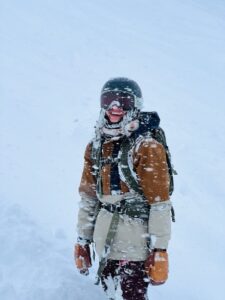 Before you even consider backcountry skiing in Japan, make sure you are trained in avalanche safety, rent, pack, or buy a beacon, shovel, and probe, know the area you’re touring, and hire a professional guide to show you the safest and best places to backcountry ski in Japan.
Before you even consider backcountry skiing in Japan, make sure you are trained in avalanche safety, rent, pack, or buy a beacon, shovel, and probe, know the area you’re touring, and hire a professional guide to show you the safest and best places to backcountry ski in Japan.
Another risk in Japan is terrain traps. Some terrain traps are sharp valleys with creeks at the bottom, unexpected cliffs and waterfalls, glide cracks, and sometimes the snow is so deep it’s hard to extract yourself after a fall. If you haven’t had to do a creek crossing in Japan, did you even ski in Japan?
Here are some of the best areas to backcountry ski in Japan:
- Mt. Chokai
- Mt. Yotei
- Daisetsuzan National Park
- Asahi-Dake
- Tokachi
Lift Tickets in Japan
Buying lift tickets in Japan varies by mountain and area. Although in well-trafficked areas, you can typically buy different types of passes for different kinds of skiers:
- Point Passes – In areas where beginners frequent point passes are handy. Each point put on a card is equivalent to a run. In Niseko, a pricier ski destination in Japan, a 12-point pass costs 5,000 Yen (~37 USD).
- Day Passes – Day passes will vary from ski area to ski area. In Hakuba, an adult day pass at Happo-One costs 6,500 Yen (~49 USD), while a day pass at Goryu costs 6,000 Yen (~45 USD). Day passes in Japan are significantly cheaper than North American rates.
- Multi-Day Passes – Are you staying in an area for an extended period? Consider buying a multi-day pass to save time and money. Although in some places, like Niseko, they require you to use the pass on consecutive days. “Multiple-day lift tickets are valid for consecutive days only and are valid until the final day of the ticket,” according to Niseko United.
- Night Passes – Like the east coast, Japan sends it night skiing. Night skiing tickets are significantly cheaper. At Akakura Onsen in Myoko, night skiing lift passes are 2,600 Yen (~19 USD). Although, night skiing in Japan is a small selection of ungroomed runs.
- All-Mountain Passes – Prefectures that are home to several nearby ski areas, like Hakuba, Niseko, and Myoko, offer all-mountain passes. All-mountain passes are valid sometimes valid at all ski areas in the area or a select few. A Hakuba Valley 5-day pass is 35,700 Yen (~275 USD). An 8-day all-mountain pass in Niseko costs 58,000 Yen (~433 USD). A Mt Myoko Mountain Pass for the whole season and access to four ski areas is 86,000 Yen (~640 USD).
Ikon and Epic passes are also accepted in Japan. The Epic Pass gives you access to Rusutsu and Hakuba Valley, while the Ikon Pass covers Niseko United and Lotte Arai Ski Resort in Myoko Kogen.
How to Get Around Japan (with a ski bag)
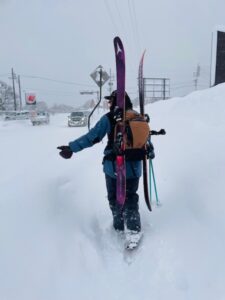 Navigating Japan can be daunting, especially if you’re lugging around a ski bag.
Navigating Japan can be daunting, especially if you’re lugging around a ski bag.
Pro Tip: Buy or borrow a ski bag with wheels. Dakine makes trusty and durable products. Here is another great example from Thule.
Flying to Japan
If you’re flying to Japan to ski, you typically go through Tokyo. A layover in Tokyo is the perfect opportunity to explore Japan’s capital and largest city for a few days. It’s important to note that Tokyo has two international airports: Haneda and Narita International Airport. Haneda is significantly closer than Narita. From Tokyo, you will use ground transportation to get to the mountains or take a relatively cheap and quick flight to Sapporo’s New Chitose Airport.
Public Transportation in Japan
Regardless of where you land, you need to be prepared to take public transportation to your ski destination, like a bus, train, or cab. Uber is only an option in Tokyo with limited availability.
Bus shuttles are the most ski bag friendly as they have under-storage. Trains and cabs are also manageable if you get creative, get to the train early, and cue so you can have one of the front seats to rest your bag, attempt to speak the language, and ask the kind locals for help. Depending on the time of the season, you may want to book your bus shuttles before you leave your country and book cabs a day ahead of time. Regardless of what you choose, Japan transportation is very reliable and easy to use.
Renting a Car in Japan
Although if you’re powder chasing, the best option for traveling around Japan is renting a car or a van. Even if you’re staying in the same place, like Hakuba Valley, the ski resorts are spread out. The free shuttles fill up quickly, especially on powder days. You will need an international license to rent a 4WD drive car.
Pro Tip: Rent a car from the city or town closest to your first ski destination. Tokyo’s options for 4WD cars are limited since the city barely sees snow.
If you can’t be hassled to travel with your ski bag, then hire Takkyubin or “the Black Cat.” It’s a useful and cheap door-to-door overnight delivery service that will drop your bags off from your arrival location to your final destination.
Packing to Ski in Japan
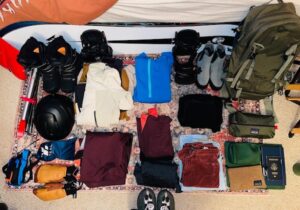 Here’s what clothes to pack for Japan in the winter:
Here’s what clothes to pack for Japan in the winter:
- The Biggest Puffy Jacket You Own (Japan gets cold)
- Pants (with room for layers)
- Thermal Long Underwear (to wear under your pants at night)
- Layers!
- Thick Wool Socks
- Slippers
- Waterproof Boots
- Beanie
- Mittens
Here’s what gear to pack for Japan to ski:
- Powder Board or Powder Skis (at least 109 underfoot or higher)
- Ski Helmet
- Goggles
- Gloves
- Waterproof Ski Bibs (keep the powder out)
- Insulated Jacket
- Mid-layers (emphasis on the plural)
- Base-layers
- Balaclava
- Ski Socks
- Ski-specific Backpack
- Beacon
- Shovel
- Probe
- Skins (if you ski, this could even be helpful on the resort where it gets flat and you have to hike)
- Touring Gear (if you’re getting after it in the backcountry)
Other Things to Do in Japan
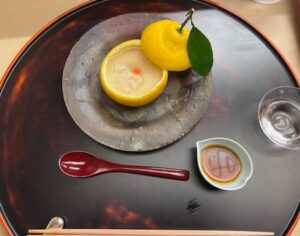 Eat all of the food in Japan and bring some home with you too. Regardless of your budget or where you go to eat in Japan, you will be satisfied. Convenient stores are stocked with the perfect ski lunch or après snack, like rice triangles, meat hot buns, and goo packets filled with vitamins and minerals.
Eat all of the food in Japan and bring some home with you too. Regardless of your budget or where you go to eat in Japan, you will be satisfied. Convenient stores are stocked with the perfect ski lunch or après snack, like rice triangles, meat hot buns, and goo packets filled with vitamins and minerals.- Go out for Izakaya or ramen at small locally-run establishments, like Restaurant Cheshire in Hakuba.
- Spend a few days in Tokyo and explore the massive city. Visit temples and shrines, go shopping, get lost, and splurge on a Kaiseki meal at Kikunoi.
- Go onsen in a Japanese hot spring. Onsens are just like hot springs where the water is sourced from the earth and dissolved with natural minerals, but they are steeped in Japanese history and proper etiquette is to be followed. Onsens are typically divided by gender. You have to undress, wash your body, and put your hair up before entering an onsen. Japanese are typically quiet places to soak and relax. If you respect the etiquette, it’s the perfect place to immerse yourself in Japanese culture and hot water after a day of shredding.
- Find the snow monkeys!
Tips for Visiting Japan
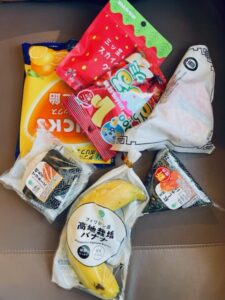 Stay in small homestays, like Wasabi Lodge, where you get to know the owners and their recommendations on the surrounding area.
Stay in small homestays, like Wasabi Lodge, where you get to know the owners and their recommendations on the surrounding area.- If you’re #vanlife in Japan, utilize Michi-no-Ekis. They offer places to park and sleep, use the restroom, eat food, buy goods, and even stream on wifi. These overnight rest stops are all over Japan.
- If you have tattoos, call before you go to an onsen to ensure you are allowed to soak.
- Learn a few key phrases in Japanese. It’s not only respectful, but it will also get you further, especially when it comes to public transportation and booking reservations. Apps like Google Translate and Duolingo are helpful!
- Are you visiting Japan in January or February? Make dinner reservations ahead of time.
- Use Apps like Skyscanner and Kiwi to book cheap flights.
- Plan to experience nightlife in Japan? Bring an old jacket with you because bars in Japan allow smoking inside.
- Bring slippers with you – it’s not only rude to wear shoes inside, but it’s also cozy to take them off after a day of skiing.
If your winter ski trip to Japan doesn’t consist of skiing frothy powder, dipping in an onsen, eating your weight in ramen, sushi, and hot buns, and repeating that for as long as you can, then you’re doing it wrong.

Madeleine is a freelance writer and social media manager in the outdoor, gear, and travel space. She loves being buried in the snow, running single-track, and eating gummies next to high alpine lakes. When she’s not writing or traveling, you can find Madeleine in Telluride, Colorado romping around in the San Juans.
